To clean and care for your stainless steel water bottle, use a soft brush or sponge with warm water and mild detergent. Disassemble it carefully to wash each part thoroughly with warm soapy water and a bottle brush for hard-to-reach spots. Combat odors with vinegar, baking soda, or lemon juice. Eliminate bacteria by rinsing with hot water and storing properly. Keep the lid off and check for leaks or damages regularly. For more tips on maintaining your stainless steel water bottle's hygiene and durability, embrace proper storage and maintenance techniques outlined in detail.
Choose the Right Cleaning Tools
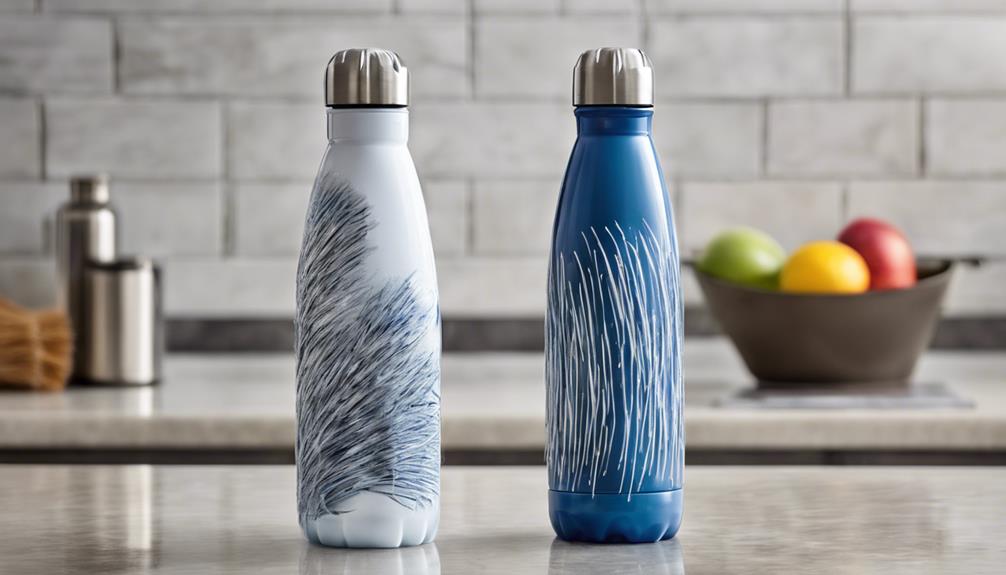
Select a soft-bristled brush or sponge to effectively clean stainless steel water bottles without causing scratches. The cleaning frequency for stainless steel water bottles depends on usage but a general recommendation is to clean them at least once a day.
For recommended tools, consider using a long-handled brush with soft bristles to reach the bottom of the bottle easily. Eco-friendly cleaning solutions such as a mixture of warm water and baking soda can be an effective way to remove odors and stains. Alternatively, vinegar diluted with water can also help disinfect your bottle naturally.
To ensure a thorough clean, pay attention to the bottle's cap and mouthpiece, which can harbor bacteria if not cleaned regularly. Remember to rinse the bottle thoroughly after cleaning to remove any residue from the cleaning solution.
Disassemble Your Water Bottle
To properly clean and care for stainless steel water bottles, it's important to disassemble your water bottle for a thorough cleaning. Begin by carefully unscrewing the cap and separating any additional components such as straws, seals, or lids. Inspect each part for any signs of wear or mold buildup. Proper reassembly is crucial to maintain the bottle's integrity and prevent leaks.
After disassembling, wash each component individually using warm soapy water, as discussed in the next subtopic.
When disassembling your water bottle, take note of how each part fits together to ensure you can reassemble it correctly. Make sure all parts are completely dry before putting the bottle back together to prevent mold growth. Additionally, store the disassembled parts in a well-ventilated area to prevent any moisture buildup. Proper storage solutions can help maintain the cleanliness of your water bottle components, ensuring they're ready for use when needed.
Following these disassembly and storage practices will help prolong the lifespan of your stainless steel water bottle.
Wash With Warm Soapy Water
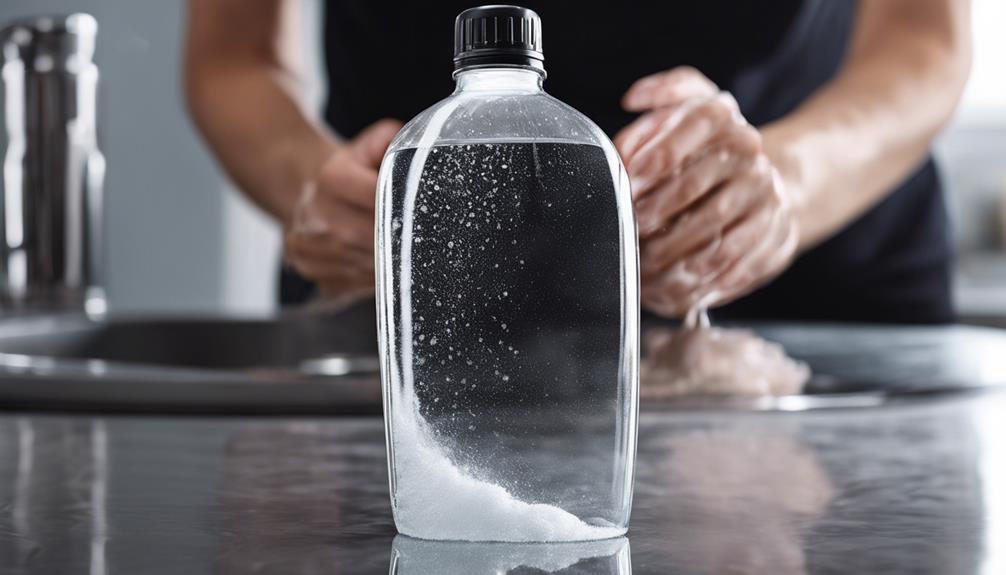
When cleaning your stainless steel water bottle, ensure to wash it thoroughly with warm soapy water to remove any dirt or residue. Begin by filling your sink with hot water and adding a small amount of gentle detergent.
Submerge the bottle in the soapy water and use a soft sponge or cloth to scrub the interior and exterior surfaces. Pay close attention to any areas with stubborn stains or odors, giving them a bit of extra scrubbing to ensure they're fully cleaned.
After scrubbing, rinse the bottle thoroughly with hot water to remove any soap residue. Make sure to rinse multiple times to guarantee all soap is removed.
Once rinsed, shake out any excess water and allow the bottle to air dry completely with the cap off. This step is crucial in preventing any mold or mildew from forming inside the bottle.
Use a Bottle Brush for Scrubbing
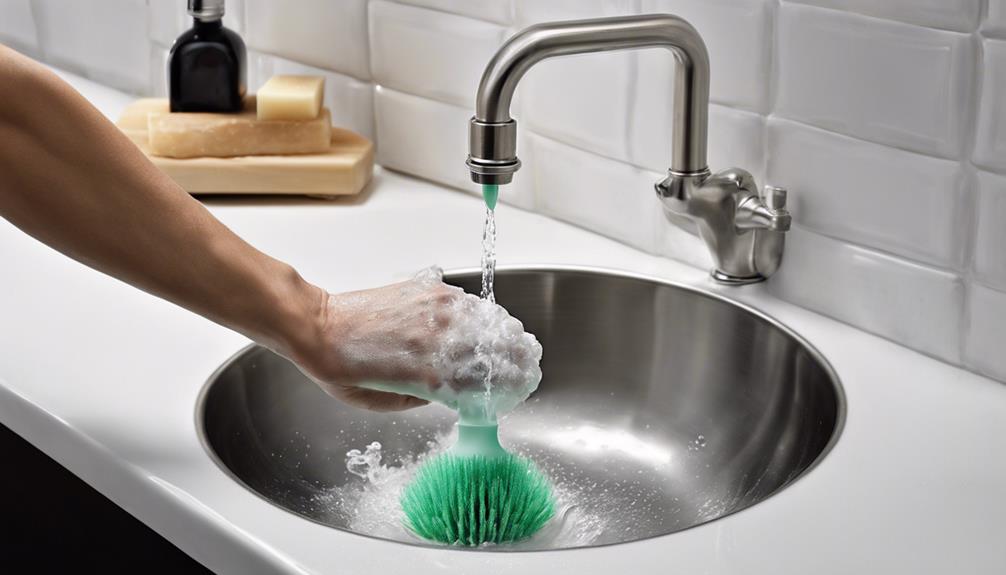
Consider using a bottle brush for thorough scrubbing of hard-to-reach areas inside your stainless steel water bottle. When it comes to deep cleaning and removing stubborn stains from your water bottle, a bottle brush is an essential tool. The bristles of the brush can effectively dislodge any residue or buildup that may be present in the crevices of the bottle.
To ensure proper bottle sterilization, it's recommended to use a bottle brush in conjunction with warm soapy water. The brush will help reach areas that are difficult to clean with just a cloth or sponge. After scrubbing the interior of the bottle, rinse it thoroughly to remove any soap residue.
Once you have cleaned your stainless steel water bottle with a bottle brush, it's crucial to allow it to dry completely. Proper drying will prevent the growth of bacteria and mold inside the bottle.
Pay Attention to Odors
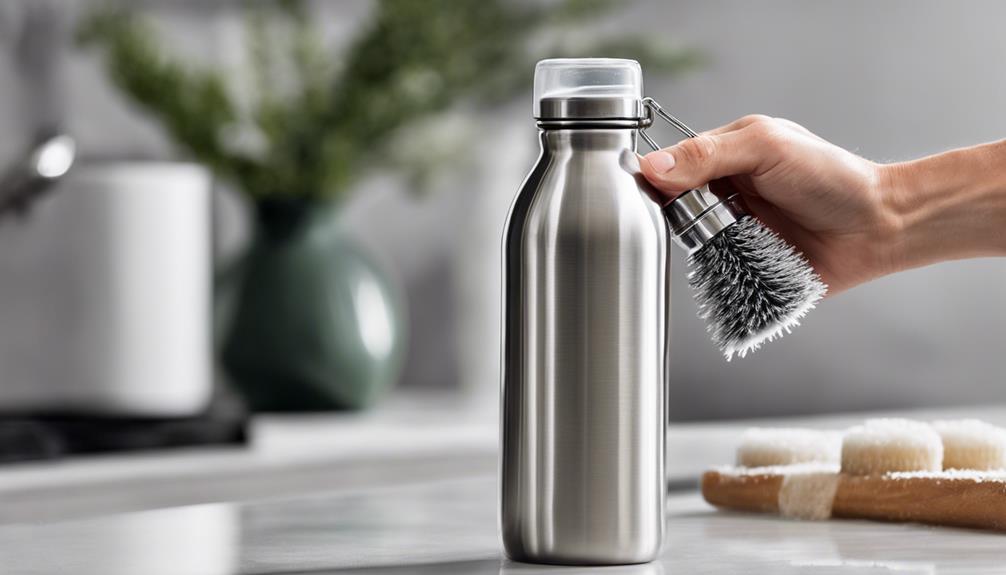
When it comes to odors in your stainless steel water bottle, it's crucial to address them promptly.
Various methods can effectively eliminate odors, ensuring your bottle stays fresh.
Additionally, following prevention tips and using safe cleaning materials are key to maintaining a pleasant odor-free bottle.
Odor Elimination Methods
To effectively eliminate odors from your stainless steel water bottle, utilize proven methods recommended by experts in the field. Start by creating a vinegar solution or a baking soda paste.
For the vinegar solution, mix equal parts water and white vinegar, then fill your bottle and let it sit for a few hours before rinsing thoroughly.
If you opt for a baking soda paste, combine baking soda with water to form a thick paste, spread it inside the bottle, and let it sit before scrubbing and rinsing.
Another effective method is using lemon juice or essential oils. Lemon juice's acidity helps combat odors, so fill your bottle with lemon juice and let it sit overnight before rinsing.
Essential oils like tea tree or lavender can also neutralize odors. Add a few drops to water, swish it around the bottle, and let it sit for a few hours before rinsing thoroughly.
Prevention Tips
Regularly monitoring for any unusual odors is essential to prevent the buildup of unpleasant smells in your stainless steel water bottle.
Preventing rust and avoiding scratches on your bottle's surface is crucial in maintaining its integrity. To achieve this, refrain from using abrasive materials or harsh chemicals during cleaning. Opt for soft cloths or sponges instead.
When storing your stainless steel water bottle, ensure it's kept in a dry and well-ventilated area. Moisture can lead to rust formation, compromising the quality of your bottle.
Additionally, be mindful of how you handle your bottle to prevent accidental scratches that may harbor bacteria and odors. Storing it properly and avoiding spills not only maintains the cleanliness of your bottle but also prolongs its lifespan.
Safe Materials for Cleaning
Choose cleaning materials for your stainless steel water bottle carefully to ensure safe maintenance, paying particular attention to any lingering odors. Opt for eco-friendly options such as biodegradable cleaners and non-toxic products to keep your bottle clean without exposing yourself to harmful chemicals. Chemical-free solutions are essential to maintain the integrity of the stainless steel and ensure that no harmful residues linger inside the bottle.
Biodegradable cleaners are a great option as they break down naturally, reducing environmental impact. These products are often made from renewable resources and are free from harsh chemicals that could potentially leach into your drinking water. Non-toxic products are also crucial, as they ensure that no harmful substances come into contact with the water you consume.
When selecting cleaning materials, always check for any added fragrances or chemicals that could leave behind unwanted odors in your stainless steel water bottle. By prioritizing eco-friendly, biodegradable, and non-toxic options, you can effectively clean your bottle while keeping it safe for regular use.
Rinse Thoroughly
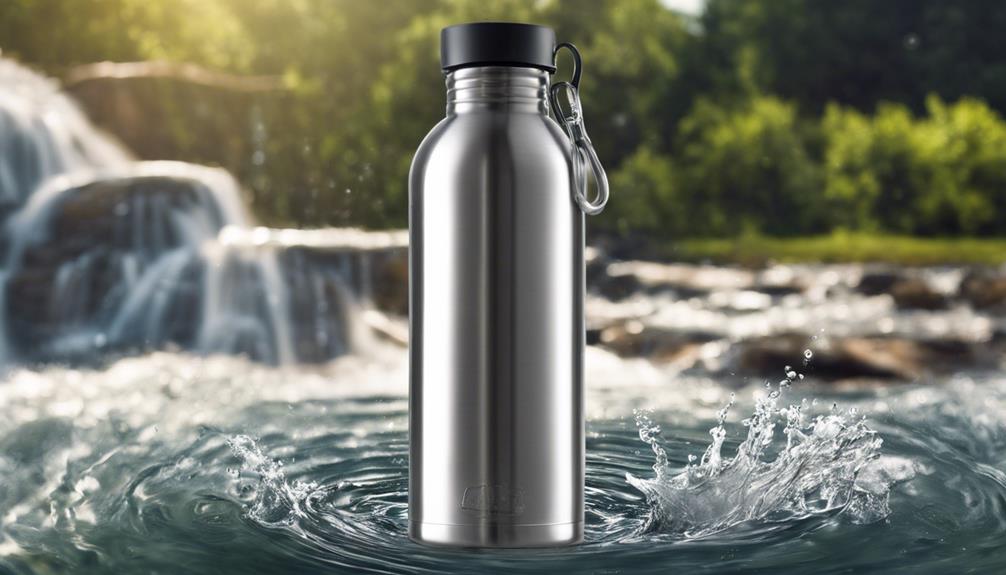
To ensure your stainless steel water bottle remains clean and odor-free, begin by giving it a thorough rinse with hot water.
Next, use a mild detergent to wash the bottle, making sure to cover all surfaces.
Hot Water Rinse
How effectively does a hot water rinse eliminate residues and maintain the cleanliness of your stainless steel water bottle?
Boiling water is a powerful tool for sterilization, effectively killing bacteria and germs that may be lingering in your bottle. The high temperature of boiling water ensures a thorough cleanse, leaving your bottle sanitized and safe for reuse.
- Sterilization: Boiling water reaches high temperatures that effectively sterilize your stainless steel water bottle.
- Elimination of Bacteria: The heat from the hot water rinse helps eliminate bacteria and germs, ensuring a hygienic environment.
- Deep Cleanse: The hot water rinse penetrates deep into the bottle, removing any stubborn residues that may be present.
Use Mild Detergent
Consider utilizing a mild detergent when cleaning your stainless steel water bottle, ensuring to rinse thoroughly to remove any soap residue. Opt for eco-friendly options to minimize environmental impact.
To begin, fill your bottle with warm water and add a small amount of mild detergent. Secure the lid tightly and shake the bottle vigorously to dislodge any grime. Use a bottle brush to scrub the interior, paying close attention to corners and crevices. Rinse the bottle multiple times with clean water to ensure all detergent is removed.
Proper storage of your water bottle is crucial; store it with the lid off to prevent any lingering moisture. When cleaning, opt for gentle motions to avoid scratching the stainless steel surface. Remember, scratches can harbor bacteria and compromise the integrity of your bottle.
Air Dry Completely
Ensuring your stainless steel water bottle air dries completely after rinsing thoroughly is essential to prevent any moisture-related issues.
Proper storage and drying techniques play a crucial role in maintaining your bottle's cleanliness and longevity.
- Proper Storage: Store your stainless steel water bottle in a well-ventilated area to allow air circulation and prevent moisture buildup.
- Use a Drying Rack: Invest in a specialized bottle drying rack to ensure proper air circulation around the entire surface of the bottle.
- Avoid Towel Drying: While tempting, avoid towel drying your bottle as it can leave behind lint and moisture, hindering the drying process.
Dry Completely After Washing
Ensure that the stainless steel water bottle is thoroughly dried after washing to prevent any residual moisture from causing bacterial growth or odors.
After washing your bottle, you have two main options for drying: towel drying and air drying.
Towel drying involves using a clean, dry cloth to wipe down the interior and exterior of the bottle, ensuring that all moisture is absorbed. This method is quick and effective, but be mindful of any hard-to-reach areas that may still contain water.
Alternatively, air drying allows the bottle to dry naturally without the use of a towel. This method is effective in preventing moisture buildup inside the bottle, reducing the risk of bacterial growth. When air drying, ensure that the bottle is placed upside down to allow any remaining water to drip out.
Proper storage tips include storing the bottle with the cap off to promote airflow and prevent any lingering moisture from causing unpleasant odors.
Avoid Harsh Chemicals
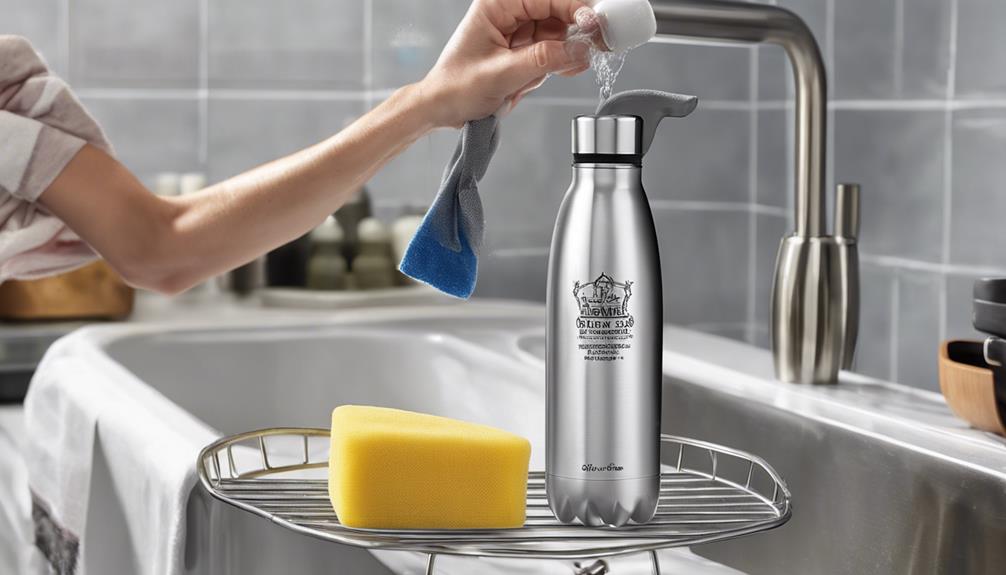
When cleaning your stainless steel water bottle, avoid harsh chemicals that can damage the bottle's surface. Opt for safe cleaning methods and natural alternatives to ensure the longevity of your bottle.
Harsh chemicals can corrode the steel and affect the quality of your drinking water, so it's essential to be cautious with your cleaning products.
Safe Cleaning Methods
To maintain the integrity of your stainless steel water bottle, always opt for gentle cleaning methods that steer clear of harsh chemicals. Eco-friendly cleaning and DIY cleaning solutions are effective alternatives that aren't only safe for the environment but also for your health.
Here are some safe cleaning methods to keep your stainless steel water bottle in top condition:
- Vinegar Solution: Create a mixture of equal parts water and white vinegar to clean the inside of your bottle. Let it sit for a few minutes before rinsing thoroughly.
- Baking Soda Paste: For stubborn stains, make a paste using baking soda and water. Apply the paste to the affected area, scrub gently, and rinse off with warm water.
- Lemon Juice: A mixture of lemon juice and water can help remove odors from your bottle. Let it sit for a while before rinsing to leave your bottle smelling fresh and clean.
Natural Cleaning Alternatives
Gently cleaning your stainless steel water bottle using natural alternatives isn't only effective but also ensures the longevity of your bottle without harsh chemicals. When looking for eco-friendly options, homemade cleaners are a great choice.
One effective natural alternative is a vinegar solution. Mix equal parts of water and white vinegar, then use this solution to soak your bottle or scrub its interior with a bottle brush. Vinegar is known for its antibacterial properties and can help remove odors and stains from your stainless steel bottle.
Another natural cleaning alternative is lemon juice. The acidity of lemon juice makes it a powerful cleaner that can help break down residue and grime inside your water bottle. Simply squeeze some fresh lemon juice into your bottle, add a bit of water, and shake it vigorously. Let it sit for a few minutes before rinsing thoroughly.
Deep Clean With Baking Soda
For a thorough cleaning of your stainless steel water bottle, utilize baking soda to achieve optimal results. Baking soda benefits your bottle by effectively removing tough stains and odors without damaging the stainless steel material.
Follow these deep clean techniques for the best outcome:
- Create a Baking Soda Paste: Mix baking soda with water to create a thick paste. Apply this paste to the interior of your bottle, focusing on any stubborn stains or lingering odors.
- Scrub and Soak: Use a bottle brush or a soft cloth to scrub the baking soda paste around the bottle's interior. Let the paste sit for at least 15-30 minutes to allow it to work its magic on the stains and odors.
- Rinse Thoroughly: After scrubbing and soaking, rinse your bottle thoroughly with warm water to remove the baking soda residue. Repeat the process if necessary until your bottle looks and smells fresh.
Keep Your Bottle Fresh

Maintaining a fresh stainless steel water bottle is essential for ensuring its longevity and optimal performance. To keep your bottle fresh, consider using a storing solution like a mix of water and white vinegar. This solution helps control odors by eliminating bacteria that can cause unpleasant smells.
Additionally, regularly cleaning your bottle with mild soap and warm water is crucial for freshness maintenance. Ensure you reach all crevices, including the cap and mouthpiece, to prevent the buildup of residue that can lead to odors over time. Utilizing cleaning hacks such as using a bottle brush or soaking in a solution of baking soda and water can further aid in keeping your bottle fresh.
Remember to rinse your bottle thoroughly after cleaning to remove any cleaning product residue that might affect the taste of your water. By incorporating these freshness maintenance practices into your routine, you can enjoy a clean and fresh stainless steel water bottle every time you hydrate.
Store Your Bottle Properly
Ensure to dry your stainless steel water bottle thoroughly after each use to prevent bacterial growth.
Store your bottle away from direct heat sources to maintain its quality and durability.
Following these simple steps will help prolong the lifespan of your stainless steel water bottle.
Dry Bottle After Use
After using your stainless steel water bottle, make sure to thoroughly dry it to prevent any potential issues with mold or bacteria growth. Towel drying and allowing the bottle to air dry are essential steps in maintaining the cleanliness and integrity of your bottle.
Here are three important tips for drying your stainless steel water bottle effectively:
- Towel Dry: Use a clean, dry cloth to wipe down the interior and exterior of the bottle to remove any moisture and residue. Pay special attention to crevices and the mouthpiece where water can accumulate.
- Air Dry: Once you've towel dried the bottle, leave it in a well-ventilated area with the lid off to air dry completely. This helps to ensure that all moisture evaporates, preventing the growth of mold or bacteria.
- Prevent Rusting: Properly drying your stainless steel water bottle also helps prevent rusting. Moisture left in the bottle can lead to the formation of rust over time, compromising the quality of the bottle and potentially impacting your health.
Store Away From Heat
Properly store your stainless steel water bottle away from heat sources to maintain its quality and durability. Heat exposure can adversely affect the integrity of your bottle, potentially causing warping or discoloration. When exposed to high temperatures, stainless steel can expand, leading to deformation in the bottle's shape.
Additionally, extreme heat can compromise the vacuum seal in insulated bottles, reducing their ability to keep liquids hot or cold.
To ensure the longevity of your stainless steel water bottle, store it in a cool and dry place, away from direct sunlight or heat-emitting appliances. Proper storage not only preserves the bottle's appearance but also safeguards its functionality.
Avoid leaving your bottle in a hot car or near heaters, as prolonged exposure to heat can impact the bottle's performance over time. By taking simple precautions and storing your stainless steel water bottle correctly, you can extend its lifespan and maintain its quality for years to come.
Check for Leaks and Damages
Inspect the stainless steel water bottle thoroughly for any signs of leaks or damages. Ensure the bottle is dry before starting the inspection. Look for any cracks, dents, or areas where the metal may have weakened. Addressing these issues promptly can prevent leaks and further damage.
Here are some steps to follow:
- Check Seams and Welds: Examine the seams and welds of the bottle for any signs of separation or corrosion. These areas are common places for leaks to develop.
- Inspect the Cap and Lid: Check the cap and lid for any cracks or misalignments that could cause leaks. Make sure the seals are intact and functioning properly.
- Examine the Exterior: Look for scratches, dents, or discoloration on the outer surface of the bottle. While these may not affect the bottle's functionality, they can impact its appearance and durability.
If you find any leaks or damages, consider your repair options or look into purchasing replacement parts to keep your stainless steel water bottle in top condition.
Replace Seals and Gaskets
To ensure the optimal performance of your stainless steel water bottle, regularly check and replace seals and gaskets as necessary. Seals are crucial components that prevent leaks and maintain the temperature of your beverages. Over time, seals can wear out or get damaged, leading to potential leaks. When replacing seals, ensure they're compatible with your specific water bottle model to guarantee a proper fit and function.
When it comes to gaskets, proper care is essential for their longevity. Clean gaskets with mild soap and water regularly to prevent buildup of residue, which can affect their sealing ability. Inspect gaskets for any signs of wear, such as cracks or tears, and replace them promptly to avoid leaks and maintain the integrity of your water bottle.
Regular Maintenance Tips
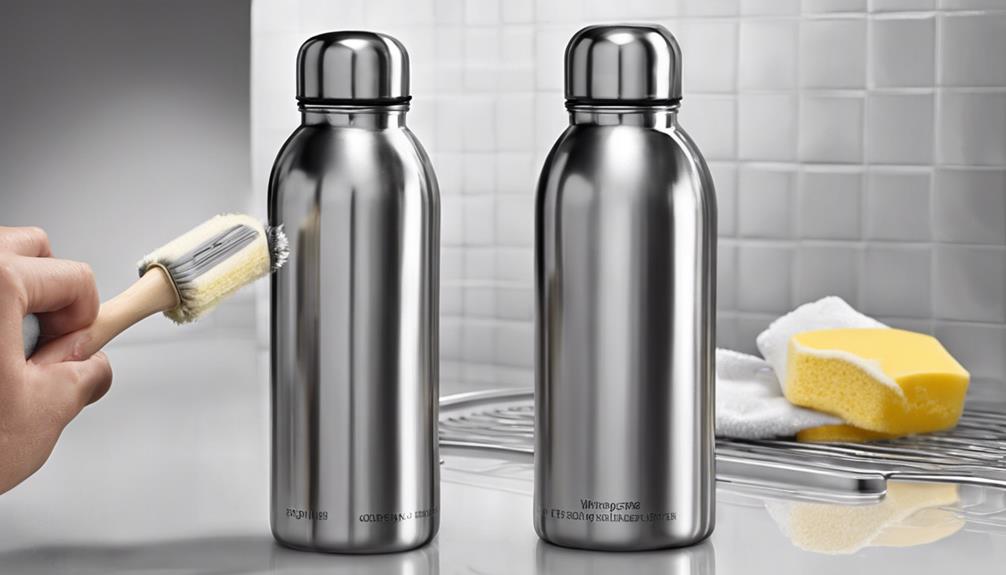
Regularly cleaning and maintaining your stainless steel water bottle is essential for ensuring its longevity and optimal performance. To keep your bottle in top condition, consider the following maintenance tips:
- Storage tips:
Store your stainless steel water bottle with the lid off when not in use to allow air circulation and prevent moisture buildup, which can lead to the growth of mold and mildew.
- Preventing stains:
Avoid leaving acidic or colored beverages in your bottle for extended periods, as these can cause stains. If your bottle does develop stains, a solution of equal parts water and white vinegar can help remove them effectively.
- Regular deep cleaning:
Periodically deep clean your bottle with a mixture of warm water and mild dish soap, using a bottle brush to scrub the interior thoroughly. Rinse well and allow it to air dry completely before storing or using it again.
Frequently Asked Questions
Can I Use Bleach to Clean My Stainless Steel Water Bottle?
You should avoid using bleach to clean your stainless steel water bottle as it can damage the metal. There are safer bleach alternatives like vinegar or baking soda that are effective for stainless steel maintenance and disinfection.
How Often Should I Replace the Silicone Seals?
Replacing silicone seals is crucial for maintaining water bottle integrity. On average, silicone seals last 6-12 months with proper maintenance. Regularly inspect seals for wear and tear, replacing as needed to ensure optimal performance and prevent leaks.
Is It Safe to Use Essential Oils to Remove Odors?
To remove odors from your stainless steel water bottle, it is safe to use essential oils sparingly. For a thorough clean, try a vinegar soak or lemon juice with a baking soda scrub. These methods are effective and safe.
Can I Clean My Bottle in the Dishwasher?
To maintain your bottle, hand washing is recommended for longevity. Dishwashers can be harsh, affecting the bottle's finish. Gentle cleaning methods ensure lasting use. Remember, proper maintenance enhances durability and hygiene.
How Can I Remove Stubborn Stains From My Water Bottle?
To remove stubborn stains from your water bottle, create a paste of baking soda and water, scrub it on the affected areas. For tougher stains, soak the bottle in a vinegar solution overnight. Rinse thoroughly.
Conclusion
Keep your stainless steel water bottle sparkling clean and in top condition with these simple maintenance tips.
By regularly cleaning and caring for your bottle, you can ensure it remains odor-free, leak-proof, and ready for everyday use.
Remember to store it properly and check for any signs of wear and tear.
With a little bit of effort, your water bottle will continue to serve you well for years to come.

